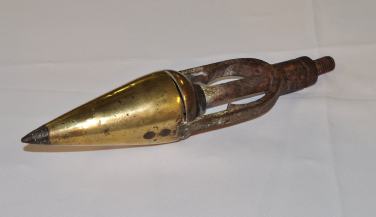
HM Customs in Queenstown
This exhibition features some interesting tools used by Customs Officers in examining ships' cargoes. A beautifully illuminated scroll expresses thanks to John McCarthy, Customs Officer in Queenstown in the early 1900s.
Plans for the Customs House in Queenstown dated 1896 are also on show.

This sampling iron was let down into the hold of the grain ships, drawn up and the captured sample tested for quality.

H. M. Customs
Originally the term Customs meant any customary (regular) payments or dues of any kind payable to the king or to the Church. It then became restricted to duties payable to the King specifically on import or export of goods. The first customs officers were appointed in England in 1294. Medieval taxes levied on exports and imports encouraged the shipping of goods undetected by the customs service. Later excise duties were imposed on many luxury items including wool, salt, tobacco and brandy.
The service developed and at each port Customs Officers were empowered to search cargoes for contraband (using specialist instruments); supervising discharge of cargo; collecting dues and enforcing quarantine regulations. Revenue cruisers patrolled the coasts on the look out for smugglers.
The British system continued in Ireland until 1922 when the Irish Customs and Excise Service was set up in an almost identical form. The officers simply changed posts from one system to another.
